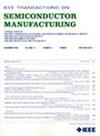Improvement of Plasma Etching Endpoint Detection With Data-Driven Wavelength Selection and Gaussian Mixture Model
IF 2.3
3区 工程技术
Q2 ENGINEERING, ELECTRICAL & ELECTRONIC
引用次数: 0
Abstract
The signal-to-noise ratio of optical emission spectroscopy (OES) data has decreased as the plasma etching process has advanced. As a result, not only the advanced endpoint detection method was required, but also the selection of more informative wavelengths. This paper proposes an improved endpoint detection algorithm by combining data-driven wavelength selection and a Gaussian mixture model (GMM). The data-driven wavelength selection algorithm finds the correlation between training data and a sigmoid function of time. Then, using the fitted GMM of the training data in latent space, the endpoint of the test data is determined in real-time. The proposed algorithm’s performance was evaluated using real OES data, comprised of seven operations. The correlation-based wavelength selection algorithm significantly reduced detection error by 70.2% when compared to the conventional method, which selects a few wavelengths manually based on prior knowledge. Additionally, the GMM detection method clustered OES data from low open area wafers much more clearly than the recently proposed method using GMM. This demonstrates that combining correlation-based wavelength selection with GMM is an effective method for detecting endpoints during plasma etching of small open area wafers.基于数据驱动波长选择和高斯混合模型的等离子体蚀刻端点检测改进
随着等离子体刻蚀工艺的发展,发射光谱(OES)数据的信噪比逐渐降低。因此,不仅需要先进的端点检测方法,而且需要选择更多的信息波长。本文将数据驱动波长选择与高斯混合模型(GMM)相结合,提出了一种改进的端点检测算法。数据驱动的波长选择算法找到训练数据与时间的s型函数之间的相关性。然后,利用训练数据在潜在空间的拟合GMM,实时确定测试数据的端点。使用由7个操作组成的真实OES数据对该算法的性能进行了评估。与传统的基于先验知识手动选择少量波长的方法相比,基于相关性的波长选择算法显著降低了检测误差70.2%。此外,GMM检测方法比最近提出的使用GMM的方法更清楚地聚类来自低开区晶圆的OES数据。这表明,将基于相关的波长选择与GMM相结合是一种有效的小开口晶圆等离子体刻蚀过程中检测端点的方法。
本文章由计算机程序翻译,如有差异,请以英文原文为准。
求助全文
约1分钟内获得全文
求助全文
来源期刊

IEEE Transactions on Semiconductor Manufacturing
工程技术-工程:电子与电气
CiteScore
5.20
自引率
11.10%
发文量
101
审稿时长
3.3 months
期刊介绍:
The IEEE Transactions on Semiconductor Manufacturing addresses the challenging problems of manufacturing complex microelectronic components, especially very large scale integrated circuits (VLSI). Manufacturing these products requires precision micropatterning, precise control of materials properties, ultraclean work environments, and complex interactions of chemical, physical, electrical and mechanical processes.
 求助内容:
求助内容: 应助结果提醒方式:
应助结果提醒方式:


